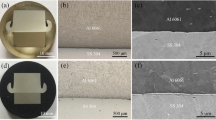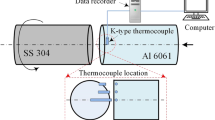Abstract
Aluminum alloy and stainless steel were joined by a continuous-drive axial friction welding machine in this study. The effects of welding parameters on the morphology, microstructure, microhardness, tensile strength, and fracture surface of dissimilar joints were analyzed. The distribution, thickness, and composition of intermetallic compound (IMC) were also discussed. Results showed that the formation of flash only was on the aluminum side because 6061 Al underwent extensive deformation during welding. Al and Fe elements diffused at the bonding interface and formed the IMC layer. The IMC thickness near the 1/2 radius was the smallest, and the thinnest at the center region. With the increase of friction pressure, the tensile strength of joint first increased and then decreased. When forge pressure was below 220 MPa, joint strength was approximately linearly related to the forge pressure. Edge regions of joints had achieved metallurgical bonding. The central region was the weak joining, and the fracture surface contained some cracks, IMCs, and a small amount of dimples.












Similar content being viewed by others
References
Reddy MG, Rao SA, Mohandas T (2008) Role of electroplated interlayer in continuous drive friction welding of AA6061 to AISI 304 dissimilar metals. Sci Technol Weld Join 13(7):619–628
Karakizis PN, Pantelis DI, Dragatogiannis DA, Bougiouri VD, Charitidis CA (2019) Study of friction stir butt welding between thin plates of AA5754 and mild steel for automotive applications. Int J Adv Manuf Technol 102(9):3065–3076
Huang Y, Huang T, Wan L, Meng X, Zhou L (2019) Material flow and mechanical properties of aluminum-to-steel self-riveting friction stir lap joints. J Mater Process Technol 263:129–137
Bhamji I, Preuss M, Threadgill PL, Addison AC (2011) Solid state joining of metals by linear friction welding: a literature review. Mater Sci Technol 27(1):2–12
Derazkola HA, Khodabakhshi F (2019) Underwater submerged dissimilar friction-stir welding of AA5083 aluminum alloy and A441 AISI steel. Int J Adv Manuf Technol 102(9):4383–4395
Wan L, Huang Y (2018) Friction welding of AA6061 to AISI 316L steel: characteristic analysis and novel design equipment. Int J Adv Manuf Technol 95(9):4117–4128
Wang T, Sidhar H, Mishra RS, Hovanski Y, Upadhyay P, Carlson B (2018) Friction stir scribe welding technique for dissimilar joining of aluminium and galvanised steel. Sci Technol Weld Join 23(3):249–255
Ogawa D, Kakiuchi T, Hashiba K, Uematsu Y (2019) Residual stress measurement of Al/steel dissimilar friction stir weld. Sci Technol Weld Join:1–10
Abioye TE, Mustar N, Zuhailawati H, Suhaina I (2019) Prediction of the tensile strength of aluminium alloy 5052-H32 fibre laser weldments using regression analysis. Int J Adv Manuf Technol 102(5):1951–1962
Sahin M (2007) Evaluation of the joint-interface properties of austenitic-stainless steels (AISI 304) joined by friction welding. Mater Des 28(7):2244–2250
Nicholas ED (2003) Friction processing technologies. Weld World 47(11):2–9
Kimura M, Kusaka M, Kaizu K, Nakata K, Nagatsuka K (2016) Friction welding technique and joint properties of thin-walled pipe friction-welded joint between type 6063 aluminum alloy and AISI 304 austenitic stainless steel. Int J Adv Manuf Technol 82(1):489–499
Maalekian M (2007) Friction welding – critical assessment of literature. Sci Technol Weld Join 12(8):738–759
Luo J, Ye YH, Xu JJ, Luo JY, Chen SM, Wang XC, Liu KW (2009) A new mixed-integrated approach to control welded flashes forming process of damping-tube–gland in continuous drive friction welding. Mater Des 30(2):353–358
Sahin M (2009) Characterization of properties in plastically deformed austenitic-stainless steels joined by friction welding. Mater Des 30(1):135–144
Yılmaz M, Çöl M, Acet M (2003) Interface properties of aluminum/steel friction-welded components. Mater Charact 49(5):421–429
Kimura M, Ishii H, Kusaka M, Kaizu K, Fuji A (2009) Joining phenomena and joint strength of friction welded joint between aluminium–magnesium alloy (AA5052) and low carbon steel. Sci Technol Weld Join 14(7):655–661
James JA, Sudhish R (2016) Study on effect of interlayer in friction welding for dissimilar steels: SS 304 and AISI 1040. Procedia Technol 25:1191–1198
Wang T, Sidhar H, Mishra RS, Hovanski Y, Upadhyay P, Carlson B (2019) Effect of hook characteristics on the fracture behaviour of dissimilar friction stir welded aluminium alloy and mild steel sheets. Sci Technol Weld Join 24(2):178–184
Lee WB, Yeon YM, Kim DU, Jung SB (2003) Effect of friction welding parameters on mechanical and metallurgical properties of aluminium alloy 5052–A36 steel joint. Mater Sci Technol 19(6):773–778
Kimura M, Suzuki K, Kusaka M, Kaizu K (2017) Effect of friction welding condition on joining phenomena, tensile strength, and bend ductility of friction welded joint between pure aluminium and AISI 304 stainless steel. J Manuf Process 25:116–125
Kobayashi A, Machida M, Hukaya S, Suzuki M (2003) Friction welding characteristics of Al-Mg aluminum alloy (A5056) and carbon steel (S45C). JSME Int J 46(3):452–459
Fukumoto S, Tsubakino H, Okita K, Aritoshi M, Tomita T (1999) Friction welding process of 5052 aluminium alloy to 304 stainless steel. Mater Sci Technol 15(9):1080–1086
Kimura M, Kusaka M, Seo K, Fuji A (2005) Joining phenomena during friction stage of A7075-T6 aluminium alloy friction weld. Sci Technol Weld Join 10(3):378–383
Chen X, Li L, Zhou D (2016) Review on the formation and inhibition mechanism of Fe-Al intermetallic compound (in Chinese). Int J Adv Manuf Technol 30(7):125–132
Lee J-M, Kang S-B, Sato T, Tezuka H, Kamio A (2003) Evolution of iron aluminide in Al/Fe in situ composites fabricated by plasma synthesis method. Mater Sci Eng A 362(1):257–263
Huang Y, Wan L, Si X, Huang T, Meng X, Xie Y (2019) Achieving high-quality Al/steel joint with ultrastrong interface. Metall Mater Trans A 50(1):295–299
van der Rest C, Jacques PJ, Simar A (2014) On the joining of steel and aluminium by means of a new friction melt bonding process. Scr Mater 77:25–28
Reza-E-Rabby M, Ross K, Overman NR, Olszta MJ, McDonnell M, Whalen SA (2018) Joining thick section aluminum to steel with suppressed FeAl intermetallic formation via friction stir dovetailing. Scr Mater 148:63–67
Kato K, Tokisue H (2004) Dissimilar friction welding of aluminium alloys to other materials. Weld Int 18(11):861–867
Su H, Wu CS, Pittner A, Rethmeier M (2014) Thermal energy generation and distribution in friction stir welding of aluminum alloys. Energy 77:720–731
Wan L, Huang Y (2018) Friction stir welding of dissimilar aluminum alloys and steels: a review. Int J Adv Manuf Technol 99(5):1781–1811
Aghajani Derazkola H, Khodabakhshi F (2019) Intermetallic compounds (IMCs) formation during dissimilar friction-stir welding of AA5005 aluminum alloy to St-52 steel: numerical modeling and experimental study. Int J Adv Manuf Technol 100(9):2401–2422
Huang Y, Xie Y, Meng X, Lv Z, Cao J (2018) Numerical design of high depth-to-width ratio friction stir welding. J Mater Process Technol 252:233–241
Huang Y, Wan L, Meng X, Xie Y, Lv Z, Zhou L (2018) Probe shape design for eliminating the defects of friction stir lap welded dissimilar materials. J Manuf Process 35:420–427
Author information
Authors and Affiliations
Corresponding authors
Additional information
Publisher’s note
Springer Nature remains neutral with regard to jurisdictional claims in published maps and institutional affiliations.
Rights and permissions
About this article
Cite this article
Liu, Y., Zhao, H., Peng, Y. et al. Microstructure characterization and mechanical properties of the continuous-drive axial friction welded aluminum/stainless steel joint. Int J Adv Manuf Technol 104, 4399–4408 (2019). https://doi.org/10.1007/s00170-019-04245-5
Received:
Accepted:
Published:
Issue Date:
DOI: https://doi.org/10.1007/s00170-019-04245-5




